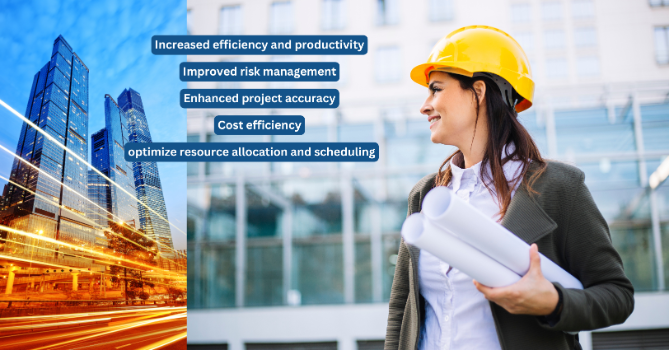
BIM and AI: Solving The BIM Challenges with Artificial Intelligence
Introduction
Building Information Modeling (BIM) has transformed the construction industry by enabling better project visualization, collaboration, and management. However, BIM alone cannot solve every challenge. Projects still face issues like data overload, cost estimation inaccuracies, and inefficient workflows. This is where Artificial Intelligence (AI) steps in. By combining AI with BIM, companies can streamline processes, improve data management, and boost overall project efficiency. AI’s ability to automate complex tasks and predict outcomes brings a new level of precision and productivity to construction. Together, BIM and AI are shaping a smarter future for the industry.
BIM Challenges in the Construction Industry
Building Information Modeling (BIM) presents several challenges that can hinder its effectiveness in the construction industry. One of the biggest hurdles is managing large sets of complex data. As projects grow, so does the information, making it difficult to process, store, and analyze data effectively. This can result in critical information getting lost or overlooked, affecting decision-making and project outcomes.

Clash detection and resolution is another significant problem. Manually identifying and resolving clashes between various design models is a labor-intensive process prone to errors. Missed clashes can lead to costly rework during construction. An effective solution is needed to streamline this process and reduce manual effort.
Cost estimation is also a pain point. Traditional methods of cost estimation are time-consuming and often lack precision, leading to budget overruns and financial risks. BIM’s current capabilities don’t fully address this issue, making it hard for companies to control project expenses.
Scheduling and resource allocation pose additional challenges. Project managers struggle to optimize schedules and allocate resources efficiently. This inefficiency can cause delays, resulting in missed deadlines and underutilized assets, which in turn drives up costs.
Collaboration and communication gaps further complicate matters. Although BIM is designed to enhance collaboration, poor information flow between stakeholders can still hinder productivity. Misunderstandings and lack of real-time updates can slow down projects and lead to costly mistakes.
Addressing these issues requires innovative solutions that seamlessly integrate with BIM’s existing functionalities. By leveraging advanced tools and technologies, companies can overcome these obstacles and achieve better project outcomes.
Role of AI in Solving BIM Challenges
Artificial Intelligence (AI) has emerged as a game-changer for the construction industry, offering solutions that enhance BIM’s capabilities. One area where AI truly shines is data management. BIM generates massive amounts of data that are challenging to handle. AI can process, analyze, and extract meaningful insights from these datasets, helping teams make informed decisions faster. It also automates data classification and organization, reducing manual work and improving efficiency.

AI also excels in clash detection and resolution. Traditional clash detection methods require a lot of manual review and still leave room for errors. AI-driven tools can automatically scan BIM models to identify and resolve design conflicts. This automation speeds up the review process and minimizes human errors, ensuring that projects stay on schedule and within budget.
When it comes to cost estimation, AI can analyze historical project data to generate accurate predictions. By integrating real-time data and machine learning algorithms, AI can forecast project costs more reliably. This helps teams plan better and allocate budgets effectively, reducing the risk of budget overruns.
Resource allocation and scheduling are also improved through AI. AI algorithms analyze project requirements, labor availability, and material supply to create optimal schedules. This results in better utilization of resources, fewer project delays, and lower costs. With AI, project managers can identify potential bottlenecks and adjust schedules proactively.
Moreover, AI enhances collaboration and communication within teams. AI-powered tools can provide real-time updates, detect discrepancies in project data, and alert relevant stakeholders. This helps everyone stay informed and aligned, reducing miscommunication and improving overall project coordination.

Finally, AI enables predictive analytics for risk management. By analyzing data patterns, AI can predict potential risks and suggest mitigation strategies before they become major issues. This proactive approach minimizes disruptions and ensures smoother project delivery.
Integrating AI with BIM is more than just a technological upgrade—it’s a strategic move that can overcome BIM’s challenges and drive project success. The synergy of BIM and AI enables teams to work smarter, faster, and more efficiently, ensuring better project outcomes for all stakeholders involved.
Benefits of Integrating AI with BIM
Integrating AI with BIM brings numerous benefits to the construction industry. One of the key advantages is increased efficiency and productivity. AI automates repetitive tasks like data entry, clash detection, and cost estimation. This allows teams to focus on more complex activities, saving time and reducing the workload.

Improved risk management is another significant benefit. AI can analyze historical data and current project conditions to predict potential issues. By identifying risks early, teams can develop strategies to mitigate them, resulting in fewer disruptions and smoother project delivery.
AI integration also leads to enhanced project accuracy. AI algorithms can analyze BIM models in detail, identifying errors and inconsistencies that human eyes might miss. This leads to more precise designs and fewer changes during the construction phase.
Additionally, AI helps achieve cost savings. By optimizing resource allocation and scheduling, AI minimizes waste and ensures materials and labor are used efficiently. It also helps in controlling costs by providing accurate project forecasts.
Overall, the combination of AI and BIM results in better decision-making, streamlined workflows, and more successful project outcomes. This powerful synergy is transforming how construction projects are planned, executed, and delivered.
Future Potential of AI in BIM
The future of AI in BIM holds immense potential for innovation and growth in the construction industry. One exciting development is AI-driven design evolution. Using generative design, AI can explore multiple design options based on project requirements and constraints, creating innovative and efficient solutions that might not be possible through manual design processes.
Another promising area is smart BIM for sustainable construction. AI can analyze energy consumption and environmental impact, helping teams develop more sustainable designs and optimize building performance.
We can also expect the rise of AI assistants in construction management. These intelligent systems can provide real-time insights, automate routine tasks, and support project managers in decision-making. As AI continues to evolve, its integration with BIM will lead to smarter, more efficient, and more sustainable projects, pushing the boundaries of what’s possible in construction.
Conclusion
The integration of AI with BIM is transforming the construction industry by addressing key challenges like data management, clash detection, cost estimation, and project scheduling. AI enhances BIM’s capabilities through automation, predictive analytics, and improved collaboration, resulting in more efficient workflows and better project outcomes. As technology advances, AI’s role in BIM will only grow, driving innovations in design, sustainability, and project management. Embracing this powerful combination allows construction professionals to work smarter, reduce costs, and deliver higher-quality projects. The future of construction lies in the synergy between BIM and AI, creating a more productive industry.